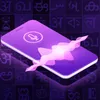Homegrown Bobble AI that made smartphone keyboards cool for Indian language users is now eyeing global expansion
Gurugram-based Bobble AI took on popular keyboard apps by Google and Microsoft with technology-led innovations. Now, the startup claims to have over five million DAUs, and is expanding globally.
When Bobble AI launched in 2015, visual messaging wasn’t as ubiquitous as it is today. Neither were Indic keyboards, which allow users to type in Indian languages, that popular. Smartphones came pre-loaded with default keyboards, and most users stuck to it. Also, communication largely centred around text.
Cut to 2019, and the entire messaging ecosystem is driven by visuals - images, GIFs, stickers, emojis, AR filters, memes, and more. There is voice too, which is gaining in popularity because of WhatsApp and the ilk.
Essentially, non-text and deeply personalised communication is the new norm for millennials, especially in the 18-29 age bracket, which is Bobble’s key target audience as well.
And, over time, companies building products for India have realised that being straight-jacketed doesn’t work anymore. So, they had to evolve.
1562076497588.png?fm=png&auto=format)
Bobble began as an app that let users convert their selfies into stickers.
Bobble AI, which began as an app that enabled users to turn their selfies into caricature stickers, has evolved a great deal too. In 2016, within a year of its launch, it added an Indic keyboard to its offering, when co-founders Ankit Prasad and Mohd. Wassem realised that only content wasn’t enough for growth. They needed a “distribution channel” to reach users.
Ankit, who dons the CEO hat, tells YourStory,
“At that time, Android and iOS had just opened their keyboard APIs, and we realised that users loved the idea of sharing content through keyboards. So, Bobble Keyboard became a distribution channel for our other products that included stickers and GIFs.”
Growth and product innovation
Between 2016 and now, Bobble AI has transitioned into a holistic Camera, Content, and Keyboard app that not only lets users personalise their communication in 22 Indian languages and six dialects, but can also predict their actions with the help of AI, deep learning, natural language processing, and data analytics. And, it does all this in real time while they are messaging.
1562076077843.jpg?fm=png&auto=format)
Ankit Prasad, Founder and CEO, Bobble AI
Ankit explains,
“We can understand user behaviour and the way they communicate. All the data generated by our products is used to derive insights. These insights are used to create better algorithms that help us understand the intent and context of a conversation, and then add predictive text, emojis, voice, and smart replies.”
The Gurugram-based startup, which also has an office in Bengaluru, claims that it now has five million daily active users (DAUs). The Bobble app has recorded more than 10 million installs on Play Store, and over 100 million pieces of content are shared on the platform every month.
The company further claims that users type 100 billion words in 30 languages every month. Most of Bobble’s users are under-29, and come from Tier II and Tier III cities, where the affinity towards regional languages is much higher.
1562076679110.png?fm=png&auto=format)
Bobble Keyboard supports a total of 30 Indian languages and dialects.
The startup’s financial health has improved over time.
Ankit reveals,
“Between 2015 and 2017, we did not generate any revenue. Building the product and improvisation was our focus. Then, sometime in 2017, we started doing about $200 a month. Towards the end of 2018, we became operationally profitable, and invested in tech and product innovation. Now, we have reached about $100,000 in monthly revenues."
In 2015, Bobble AI raised $3 million in Series A round from SAIF Partners.
It is also backed by some of the most celebrated names in the Indian startup ecosystem. These include Sachin Bansal and Binny Bansal (co-founders of Flipkart), Deep Kalra (Founder of MakeMyTrip), Amit Ranjan (Co-founder of SlideShare), Prashant Tandon and Gaurav Agarwal (CEO and CTO, respectively, of 1mg), and Prashant Malik (ex-Technical Leader of Facebook, Co-founder of LimeRoad).
Place in the Indic keyboard ecosystem
Bobble claims to be the “most engaging, most retained, and highest rated” keyboard app in India, ahead of Google Indic Keyboard and Microsoft-owned Swiftkey - its two main competitors.
In terms of downloads, Google Keyboard continues to lead the Indic keyboard space by dint of being the default app on most Android handsets. Research indicates that less than one percent of users switch from their default phone keyboards. Hence, Gboard stays on most phones.
1562076853561.png?fm=png&auto=format)
Bobble AI claims over 100 million pieces of content are shared on its platform every month.
Ankit says,
“Among all keyboards, we have the highest engagement and virality. We have unique and expressive content. When people see such visibility, it adds to our credibility. A keyboard is the core of the user’s smartphone experience. We get access to so many data points no other category of apps can even imagine.”
Besides content and keyboard, Bobble has an added offering: an AI-enabled shopping camera. It lets users take a picture of a product on-the-go, and instantly directs them to an ecommerce platform where they can make a purchase. So, if users come across a dress or a piece of jewellery or furniture, they can buy the exact item on Myntra, Flipkart, Amazon, and other websites.
The growing B2B2C business
Bobble also prides itself on the partnerships it has struck with companies that are building for Indian language users.
These include tech giants such as Baidu and Foxconn, homegrown operating system Indus, a few undisclosed smartphone makers, and popular consumer internet services such as Zomato, Tinder, ixigo, etc. It has also “enabled regional language conversations” for brands like Adidas, Reebok, Durex, and BIRA.
Ankit explains,
“This is the B2B2C component of our business. Sometimes, brands cannot build regional language services on their own and they approach us. We provide them language, content, and voice as a service, which they offer within their apps to the end-user.”
_(1)1562077280121.jpg?fm=png&auto=format)
Bobble AI offers language, content, and voice as a service to popular brands like Tinder.
This segment of the business is growing as more companies realise the need to reach Indian users in a language they are most comfortable with. This also adheres to Google’s famed mission of reaching ‘the next billion users’ in India.
“The past and current is not that important. Every company wants to appeal to the future customer, and that customer is regional,” Ankit notes.
Future growth and expansion plans
Apart from India, Bobble has tested its products in Indonesia, and is planning to expand to Thailand, Singapore, Malaysia, and other regions in Southeast Asia.
“Our next home is Indonesia,” says Ankit, adding, “culturally, Southeast Asia behaves a lot like India. In Indonesia, for instance, the official language Bahasa is derived from bhasha [which means language in Hindi]. There are many common words too. We just have to replicate their use cases.”
The startup is also looking at the UAE, where 50 percent of the population is the Indian diaspora. “We have enrolled two more popular languages,” Ankit shares, without adding specifics.
Besides international expansion, the 40-people company also wants to “achieve better efficiency” in all Indian languages by 2020.
1562076246281.jpg?fm=png&auto=format)
Bobble has launched in multiple Southeast Asian markets, and will roll out in the UAE too.
But, some challenges remain.
“Data is the biggest challenge,” Ankit reveals. “It is not available anywhere for Indian languages. There is no way we can create models by studying past data. Everything has to be generated by our own products,” he explains.
Hence, Bobble is now working with Niti Aayog and India Stack to “power” its AI models. It is also tapping into student communities and homemaker groups to generate a variety of data sets that it can mine.
“But, to ensure complete security, we are generating most of the data via our partners. We have been GDPR-compliant in the last one year,” Ankit states.
Bobble’s growth will likely continue as long as users communicate in local languages and express through visuals. Given how the Indian internet is progressing, there are big opportunities ahead!
(Edited by Megha Reddy)




![[App Fridays] SwiftKey makes communication more creative, fun, and quick, one tap at a time](https://images.yourstory.com/cs/wordpress/2018/09/SwiftKey-feature-image.png?fm=png&auto=format&h=100&w=100&crop=entropy&fit=crop)







